John Füegi & Jo Francis of Flare Productions make fantastic documentary films, including a documentary about our very own Ada Lovelace. Ada Byron Lovelace: To Dream Tomorrow includes interview with Sadie Plant and Miranda Seymour amongst others, to give an overview of her life, and locate her firmly within the history of computing. The film clearly describes the importance of Ada's Notes which accompanied the designs for the Analytical Engine. The notes anticipate the importance of the engine as a universal machine, not simply for calculating numbers, but for computing symbols and rules. What we might call algorithms and data. Füegi &Francis describe their intensive research process for the film, and cite Doron Swade's statement in the film which is worth repeating here:
"Ada saw something that Babbage in some sense failed to see. In Babbage's world his engines were bound by number. He saw that the machines could do algebra in the narrow sense that they could manipulate plus and minus signs. But all his calculating engines, his Difference Engine and his Analytical Engine, which is the programmable general purpose machine, were all bound by number, they manipulated number as a manifestation of quantity. What Lovelace saw was that number could represent entities other than quantity. So once you had a machine for manipulating numbers, if those numbers represented other things, letters, musical notes, then the machine could manipulate symbols of which number was one instance, according to rules. This is a fundamental transition from a machine which is a number cruncher to a machine that manipulates symbols according to rules, that is the transition from calculation to general purpose computation. And looking back from the present high ground of modern computing, if we're looking and sifting history for that transition, then that transtion was made explicitly by Ada in that 1843 paper."
The making of the film in 2003, coincided both with the 150th anniversary of the death of Ada, Countess Lovelace (27 November 1852), and marked Doron Swade's completion in 2002 at London's Science Museum of the printer Babbage designed to work either with the Difference Engine or the Analytical Engine. Both the engine and the printer in all their beauty are seen working in the film.
Wednesday, December 10, 2008
Tuesday, December 02, 2008
Knitting Knitting Pattern

Suzanne is busy knitting a cover for one of the HUMlab flat screens. The green text is the code of the knitting pattern for making the cover. The pattern is in Swedish, so English speakers might not get the abbreviations. We chose the green and dark grey colours to emulate a basic screen, and they just happen to co-ordinate with the jungle wallpaper in HUMlab!
The 7 flatscreens in HUMlab will be used for the HUMlab Syjunta exhibition which opens on Friday 23rd January, 16.00 til 18.00. The exhibition will present the Html Patchwork and other works made through the Open Source Embroidery workshops.
Saturday, November 29, 2008
Women and Open Source
Okay - I'll be honest here. There's a dropped stitch of an idea in Open Source Embroidery Fika here in Umeå, which I keep trying to pick up. It is this: OSE only works when it is inter-disciplinary, when people bring hardware and knitware, softwear and code-wear. Otherwise it's just tech, or just textiles (and we know the gender cliques they hide within). Although OSE Fika has made some progress in convincing embroiderers not to be scared of the tech threads, and reassuring the tech-iles not to be put-off by the text-iles, there's a lot more work to be done. We need confidence in taking things apart, questioning the ethics, the access, the utopian and dystopian models we are emulating.
As inspiration - take Aileen Derieg's essay Things Can Break: Tech Women Crashing Computers and Preconceptions. She gives an overview of women and open source, and an introduction to the Genderchangers Academy.
As inspiration - take Aileen Derieg's essay Things Can Break: Tech Women Crashing Computers and Preconceptions. She gives an overview of women and open source, and an introduction to the Genderchangers Academy.
Wednesday, November 19, 2008
Stitching the Yarn Text
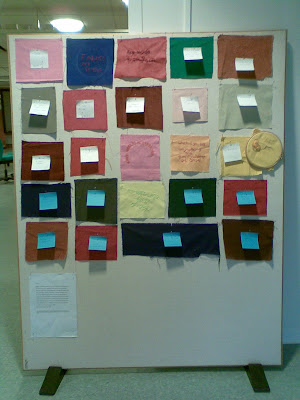 The Open Source Embroidery (OSE) Fika groups have fostered some interesting starting points of conversations about craft practices grappling with the idea of Open Source or what Camille Mousette called an 'open attitude'.
The Open Source Embroidery (OSE) Fika groups have fostered some interesting starting points of conversations about craft practices grappling with the idea of Open Source or what Camille Mousette called an 'open attitude'. 
But our discussions are fragmented across different sites and individual creative projects. I feel that there is a need to bring together the different threads within a collective work which explores the material nature of technology. So I have proposed a collectively embroidered and short text that I keep referencing: the Raqs Media Collective definition of 'Yarn'from their Lexicon of/for the Digital Commons. I think this stitched text will visually consolidate one aspect of what OSE means in relation to HUMlab and the language of new media.
In yesterdays OSE Fika we set up a paper document for people to choose the line of text they would like to embroider, and started stitching on the fabric swatches that the aesthetics department gave me in return for a lecture.
The design board for the patchwork is at HUMlab (see photo above). If you are in Umea and would like to make a patch, the text and stitchers list is available next to the design board in HUMlab, underneath the library in the Humanities building.
Sunday, November 16, 2008
Common Humanity
I'm reading Andrew Brown's memoir of his experience of Sweden from the 1970s to the present. He makes an interesting analogy between democracy, common humanity and craft circles. In Swedish a sewing circle or group is called Syjunta.
“… close to what Swedes mean by democracy: not a voting system, but a recognition of common humanity. This was the spirit that had lain behind all the craft circles and evening classes and even the passionate fishing clubs of which I had been a member.”
Andrew Brown, 2008, Fishing in Utopia: Sweden and the Future that Disappeared, Granta Books: London. p255-256
One of the remarkable experiences of the Open Source Embroidery Fika meetings is that women who haven't been able to pick up a needle and thread for ten, twenty, or even thirty years, are finding an empowered space in which they can stitch without fear of betraying their feminist principles. The recognition of 'common humanity' which we associate with the 1970s craft movement is being reinvented, bringing together women of different ages, with a mixture of intellectual and social interests. But today the language used to invigorate a culture of making, is entwined with the utopian vision of the power of social networks using the internet as our communications web.
“… close to what Swedes mean by democracy: not a voting system, but a recognition of common humanity. This was the spirit that had lain behind all the craft circles and evening classes and even the passionate fishing clubs of which I had been a member.”
Andrew Brown, 2008, Fishing in Utopia: Sweden and the Future that Disappeared, Granta Books: London. p255-256
One of the remarkable experiences of the Open Source Embroidery Fika meetings is that women who haven't been able to pick up a needle and thread for ten, twenty, or even thirty years, are finding an empowered space in which they can stitch without fear of betraying their feminist principles. The recognition of 'common humanity' which we associate with the 1970s craft movement is being reinvented, bringing together women of different ages, with a mixture of intellectual and social interests. But today the language used to invigorate a culture of making, is entwined with the utopian vision of the power of social networks using the internet as our communications web.
Tuesday, November 11, 2008
Den Röda Tråden
The OSE Fika discussion at HUMlab this afternoon focused on the material physicality of the internet and technology woven together through a web of cable which stretches across countries and across the seabed to connect continents.
Sadie Plant writes:
“Media has become interactive and hyperactive, the multiplicitous components of an immersive zone which does not begin with writing; it is directly related to the weaving of elaborate figured silks. The yarn is neither metaphorical nor literal, but quite simply material, a gathering of threads which twist and turn through the history of computing, technology, the sciences and the arts.” (Sadie Plant, 1997, Zeros + Ones, p12)
We also discussed the Raqs Media Collectives' definition of Yarn, and the way in which data cables as well as knitted yarns can carry a story. Den Röda Tråden – is the red thread which weaves through a story or an argument. In English we speak of the 'thread' of an argument, but it doesn't have a specific colour.
Red thread is also a potent emblem in a Chinese proverb - where the red thread is said to connect everyone that will ever meet. I rather like this parasitic red thread project by Stromgasse.
On a more practical note - after several failed attempts to convert the HUMlab logo into a cross stitch pattern using online software, Haishu printed out a grid and is drawing her pattern by hand, her thread is not red or pink, but deep magenta.
Artist Margareta Klingberg brought along the amazing Fiber Art Sweden catalogue. If you want to read more, I'll bring along to the OSE Fika at the Art school on Thursday 14.00 - 17.00.
Sadie Plant writes:
“Media has become interactive and hyperactive, the multiplicitous components of an immersive zone which does not begin with writing; it is directly related to the weaving of elaborate figured silks. The yarn is neither metaphorical nor literal, but quite simply material, a gathering of threads which twist and turn through the history of computing, technology, the sciences and the arts.” (Sadie Plant, 1997, Zeros + Ones, p12)
We also discussed the Raqs Media Collectives' definition of Yarn, and the way in which data cables as well as knitted yarns can carry a story. Den Röda Tråden – is the red thread which weaves through a story or an argument. In English we speak of the 'thread' of an argument, but it doesn't have a specific colour.
Red thread is also a potent emblem in a Chinese proverb - where the red thread is said to connect everyone that will ever meet. I rather like this parasitic red thread project by Stromgasse.

On a more practical note - after several failed attempts to convert the HUMlab logo into a cross stitch pattern using online software, Haishu printed out a grid and is drawing her pattern by hand, her thread is not red or pink, but deep magenta.
Artist Margareta Klingberg brought along the amazing Fiber Art Sweden catalogue. If you want to read more, I'll bring along to the OSE Fika at the Art school on Thursday 14.00 - 17.00.
Friday, November 07, 2008
Translating Stitches
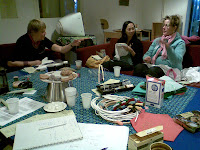 Artists and designers in Umea joined fine art students and an interaction designer and writer at the OSE Fika at the Konsthogskolan on Thursday. There was an interesting discussion about possible connections between object based programming and creating a knitted object... so we'll see what happens.
Artists and designers in Umea joined fine art students and an interaction designer and writer at the OSE Fika at the Konsthogskolan on Thursday. There was an interesting discussion about possible connections between object based programming and creating a knitted object... so we'll see what happens.Whilst computer code is always in English, knitting patterns use language specific abbreviations. Suzanne has taken on the ambitious project of knitting a cover for one of the giant flat-screens in HUMlab. The knit will include letters describing the knitting pattern for the cover. Charlene has just moved to Umea from the US and is stitching her new Swedish vocabulary by hand.
For the OSE Fika at the Art School on November 13th we will be joined by interaction designer Camille Moussette, who is an advocate of Open Source in his work. Camille is currently doing research at the Umea Institute of Design. See his HAPI project.
Wednesday, November 05, 2008
Coding a Trousseau
 The first Open Source Embroidery Fika in HUMlab was a cosy affair. I gave a talk about the OSE project, and Stefanie Wuschitz talked about why she uses open source mobile processing software for her work. To find out more go along to Miss Balthazar's Laboratory.
The first Open Source Embroidery Fika in HUMlab was a cosy affair. I gave a talk about the OSE project, and Stefanie Wuschitz talked about why she uses open source mobile processing software for her work. To find out more go along to Miss Balthazar's Laboratory.Johan described the programmers pride in their work, and the difference between neat and sloppy code. If you make your code public through open source, then you want it to be your best. We compared this pride with the tradition of making a sample craft project to show-off your skills. Such as women making an embroidery sampler, or men whittling a love spoon, to prove their talents to future partners. Maybe neat coding will be the new trousseau!
Sunday, November 02, 2008
Ada Lovelace
Ada Lovelace (1815 - 1852) was an analyst and metaphysician and is often referred to as the first computer programmer. She worked with Charles Babbage on the Analytical Engine, the precursor to the modern computer. Lovelace made extensive notes accompanying the engine, in which she describes how it could be programmed, and the broader scope of its potential. She wrote:
"The distinctive characteristic of the Analytical Engine, and that which has rendered it possible to endow mechanism with such extensive faculties as bid fair to make this engine the executive right-hand of abstract algebra, is the introduction into it of the principle which Jacquard devised for regulating, by means of punched cards, the most complicated patterns in the fabrication of brocaded stuffs. It is in this that the distinction between the two engines lies. Nothing of the sort exists in the Difference Engine. We may say most aptly that the Analytical Engine weaves algebraical patterns just as the Jacquard loom weaves flowers and leaves."
P Morrison and E Morrison (eds.), Charles Babbage and his calculating engines (New York, 1961).
I've embroidered the hyperlink that enables you to jump from this page to the web page about Ada Lovelace on the Computer History Museum's website by clicking on the words 'Ada Lovelace' above.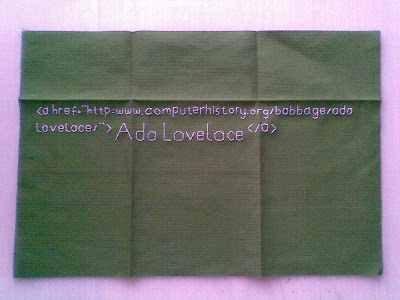
"The distinctive characteristic of the Analytical Engine, and that which has rendered it possible to endow mechanism with such extensive faculties as bid fair to make this engine the executive right-hand of abstract algebra, is the introduction into it of the principle which Jacquard devised for regulating, by means of punched cards, the most complicated patterns in the fabrication of brocaded stuffs. It is in this that the distinction between the two engines lies. Nothing of the sort exists in the Difference Engine. We may say most aptly that the Analytical Engine weaves algebraical patterns just as the Jacquard loom weaves flowers and leaves."
P Morrison and E Morrison (eds.), Charles Babbage and his calculating engines (New York, 1961).
I've embroidered the hyperlink that enables you to jump from this page to the web page about Ada Lovelace on the Computer History Museum's website by clicking on the words 'Ada Lovelace' above.

Tuesday, October 28, 2008
Open Source Embroidery Fika
Artists, designers, programmers and craftspeople are invited to come along to the Open Source Embroidery workshops run by Ele Carpenter at Umea University. The workshops will provide the opportunity to find out more about the project, share your skills and learn new ones. We’ll be discussing the ethics of creative practice, the relationship between craft and code, and making new art works. Bring your ideas, computers, cables, threads, needles and yarns…
Workshops: 14.00 - 17.00
Tues Nov 4th – HUMlab
Thurs Nov 6th – Fine Art School
Tues Nov 11th – HUMlab
Thurs Nov 13th – Fine Art School
Tues Nov 18th – HUMlab
Thurs Nov 20th – Fine Art School
HUMlab is underneath the library in the Humanities Building. The Fine Art School Konsthogskölan) is next to the river, we'll be in the sofa area by the main entrance.
The afternoons will be very informal and the schedule will be roughly:
14.00 Fika and meeting everyone
14.30 introduction by Ele
14.45 invited quests discuss their work and ideas
15.45 Fika break
16.00 Skillshare making workshop
17.00 Close
Look forward to seeing you at one or all of the workshops
Workshops: 14.00 - 17.00
Tues Nov 4th – HUMlab
Thurs Nov 6th – Fine Art School
Tues Nov 11th – HUMlab
Thurs Nov 13th – Fine Art School
Tues Nov 18th – HUMlab
Thurs Nov 20th – Fine Art School
HUMlab is underneath the library in the Humanities Building. The Fine Art School Konsthogskölan) is next to the river, we'll be in the sofa area by the main entrance.
The afternoons will be very informal and the schedule will be roughly:
14.00 Fika and meeting everyone
14.30 introduction by Ele
14.45 invited quests discuss their work and ideas
15.45 Fika break
16.00 Skillshare making workshop
17.00 Close
Look forward to seeing you at one or all of the workshops
Sunday, October 05, 2008
Re-using Fabric
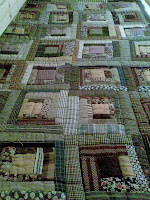 The Vasterbottens Museum here in Umea has a beautiful collection of textiles, from early linen dresses and recycled patchwork to Sami hats and reindeer reins. So many contemporary patchworkers are using new fabrics, so it was interesting to see the bumpy imperfections of sewing together fabrics of different weaves and thicknesses, which are also apparent in the Html Patchwork.
The Vasterbottens Museum here in Umea has a beautiful collection of textiles, from early linen dresses and recycled patchwork to Sami hats and reindeer reins. So many contemporary patchworkers are using new fabrics, so it was interesting to see the bumpy imperfections of sewing together fabrics of different weaves and thicknesses, which are also apparent in the Html Patchwork.
The Sami used every scrap of fabric - here the trimmed hems of clothing are used to make beautiful decorative harnesses for reindeer.
Wednesday, October 01, 2008
OSE Bliss!
Ah - the bliss of having a research fellowship is wonderful. I have spent this week reading all the emails about related art works that people have sent me over the last two years... Thank you Glittrgirl, Keith, Pete and Michelle.
One of the most amazing works is Running Stitch by Hamilton and Southern, which explores the issues of public space, data visualisation and the materiality of stitch and step through time and space.
One of the most amazing works is Running Stitch by Hamilton and Southern, which explores the issues of public space, data visualisation and the materiality of stitch and step through time and space.
Monday, September 08, 2008
Embroidered Botanic Folksonomy
 On Saturday I went to an event called The Gendered City which involved several artists running participatory events in the park. I took part in a masked ball dance, a light therapy session to protect against winter depression, and helped Amy Franceschini stitch local plants onto people's clothing (see my approximation of the Field Horsetail above).
On Saturday I went to an event called The Gendered City which involved several artists running participatory events in the park. I took part in a masked ball dance, a light therapy session to protect against winter depression, and helped Amy Franceschini stitch local plants onto people's clothing (see my approximation of the Field Horsetail above). Amy’s project Nearest Nature involved running a workshop with botanists and other participants to explore the local flora, they collected plants and renamed them with their own taxonomy. The results are on display at the Bildmuseet. Amy is also part of Future Farmers in San Francisco, so of course the work plays out a botanic folksonomy, mimicking the social taxonomies of meta-data tagging, and the resulting democratic poetry and confusion. For an introduction to the concept of folksonomy – see my essay on the NoFixedAbode website.
Friday, September 05, 2008
Html Lapptäcke
Today was my first day at HUMlab at the University of Umeå in Sweden. I'm here on a fellowship for a year to develop the open source embroidery project at HUMlab and in partnership with other departments and organisations in the town.
The Swedish words I learnt today were:
Fika - to have cake and coffee
Tack = thank you
Hej = hello
Lapptäcke = patchwork
It was a busy day at HUMlab, the Museum Studies students had a lecture on blogging, then set up their own blogs before starting to design an exhibition in Second Life. The whole session was streamed live on Second Life, for a peek - have a look at the HUMlab blog.
Umea, on first impression, has similarities with Second Life. The landscape is very flat, so you can't see the building you are looking for until you are right in front of it. This is so different from Northumberland in England where the rolling fells and valleys allow you to see the whole landscape laid out like a map. In the hills you can point to you destination and, as you walk, you have a sense of measuring the distance between where you have come from and where you are going. But now I need some new strategies for navigating a series of landmarks.
I'll be starting new projects here in Sweden, but first I want to make just one more small patchwork called 'Get Your Rabbits Mated Before Christmas' to represent the RGB and CMYK colours. The first challenge is to find the colour fabrics needed: bright green, bright yellow, black and cyan, which is a bluey-green sort of pale turquiose. If anyone in Umeå can help - please get in touch...
The Swedish words I learnt today were:
Fika - to have cake and coffee
Tack = thank you
Hej = hello
Lapptäcke = patchwork
It was a busy day at HUMlab, the Museum Studies students had a lecture on blogging, then set up their own blogs before starting to design an exhibition in Second Life. The whole session was streamed live on Second Life, for a peek - have a look at the HUMlab blog.
Umea, on first impression, has similarities with Second Life. The landscape is very flat, so you can't see the building you are looking for until you are right in front of it. This is so different from Northumberland in England where the rolling fells and valleys allow you to see the whole landscape laid out like a map. In the hills you can point to you destination and, as you walk, you have a sense of measuring the distance between where you have come from and where you are going. But now I need some new strategies for navigating a series of landmarks.
I'll be starting new projects here in Sweden, but first I want to make just one more small patchwork called 'Get Your Rabbits Mated Before Christmas' to represent the RGB and CMYK colours. The first challenge is to find the colour fabrics needed: bright green, bright yellow, black and cyan, which is a bluey-green sort of pale turquiose. If anyone in Umeå can help - please get in touch...
Friday, August 22, 2008
Activist Quilting
Here's a link to The Aids Memorial Quilt. It's a very powerful demonstration of collective quilting for collective action.
Saturday, August 02, 2008
Quilt at the Mill and Linux Magazine
The Html Patchwork has started to feature in both the linux and patchwork worlds...
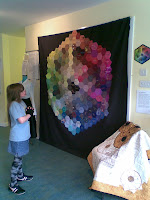 The Html Patchwork was proudly presented at the entrance to the Quilts at the Mill exhibition at Blackhall Mill in July. It was one of many quilts made by people at workshops in The Fat Quarters Shop. The community center was turned into an Aladdin's cave of fabric, stitching and stories made locally. Three different groups of Fat Quarters patchworkers contributed their patches to the Html Patchwork including the Mini Stitchers kids club, and several more experienced patchworkers. They also took on the task of sewing the patches together, transforming 216 individual artworks into a whole piece of fabric.
The Html Patchwork was proudly presented at the entrance to the Quilts at the Mill exhibition at Blackhall Mill in July. It was one of many quilts made by people at workshops in The Fat Quarters Shop. The community center was turned into an Aladdin's cave of fabric, stitching and stories made locally. Three different groups of Fat Quarters patchworkers contributed their patches to the Html Patchwork including the Mini Stitchers kids club, and several more experienced patchworkers. They also took on the task of sewing the patches together, transforming 216 individual artworks into a whole piece of fabric.
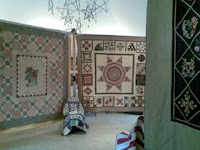 The Open Source Embroidery project, including the exhibitions at Blackhall Mill and Furtherfield's HTTP gallery, was featured in the August edition of Linux Magazine, in their 'World News' section. http://www.linux-magazine.com
The Open Source Embroidery project, including the exhibitions at Blackhall Mill and Furtherfield's HTTP gallery, was featured in the August edition of Linux Magazine, in their 'World News' section. http://www.linux-magazine.com
 The Html Patchwork was proudly presented at the entrance to the Quilts at the Mill exhibition at Blackhall Mill in July. It was one of many quilts made by people at workshops in The Fat Quarters Shop. The community center was turned into an Aladdin's cave of fabric, stitching and stories made locally. Three different groups of Fat Quarters patchworkers contributed their patches to the Html Patchwork including the Mini Stitchers kids club, and several more experienced patchworkers. They also took on the task of sewing the patches together, transforming 216 individual artworks into a whole piece of fabric.
The Html Patchwork was proudly presented at the entrance to the Quilts at the Mill exhibition at Blackhall Mill in July. It was one of many quilts made by people at workshops in The Fat Quarters Shop. The community center was turned into an Aladdin's cave of fabric, stitching and stories made locally. Three different groups of Fat Quarters patchworkers contributed their patches to the Html Patchwork including the Mini Stitchers kids club, and several more experienced patchworkers. They also took on the task of sewing the patches together, transforming 216 individual artworks into a whole piece of fabric. The Open Source Embroidery project, including the exhibitions at Blackhall Mill and Furtherfield's HTTP gallery, was featured in the August edition of Linux Magazine, in their 'World News' section. http://www.linux-magazine.com
The Open Source Embroidery project, including the exhibitions at Blackhall Mill and Furtherfield's HTTP gallery, was featured in the August edition of Linux Magazine, in their 'World News' section. http://www.linux-magazine.com
Monday, July 14, 2008
Wild Wool
 Last week I visited Allenheads Contemporary Arts in Northumberland UK. I had a wonderful time courtesy of Helen Ratcliffe and Alan Smith whose live/work residency spaces support artists to make rigorous work in the context of the Allenheads village and the Northumberland fells and dales.
Last week I visited Allenheads Contemporary Arts in Northumberland UK. I had a wonderful time courtesy of Helen Ratcliffe and Alan Smith whose live/work residency spaces support artists to make rigorous work in the context of the Allenheads village and the Northumberland fells and dales.  On my evening walk I spotted sheep wool caught on the stubbly grass being spun in the wind. I gathered the wool and finished spinning it by hand before knitting a little sample of wild wool knit. The natural lanolin moisturised my hands, and the finished sample only took a few minutes.
On my evening walk I spotted sheep wool caught on the stubbly grass being spun in the wind. I gathered the wool and finished spinning it by hand before knitting a little sample of wild wool knit. The natural lanolin moisturised my hands, and the finished sample only took a few minutes.
Friday, May 30, 2008
Sampler
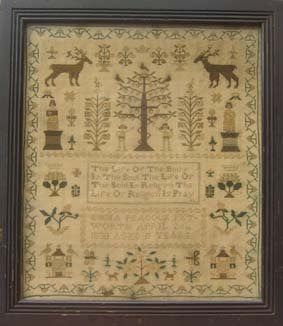 This sampler belonged to my grandparents, and is remarkable for the fact it is made by such a young girl. I've always mused on the comparisons of sampling music, embroidery, and software. The OSE workshop at Connecting Principle 2007 was called Sampling / Beta Testing - to describe the experimental phase of software and embroidery.
This sampler belonged to my grandparents, and is remarkable for the fact it is made by such a young girl. I've always mused on the comparisons of sampling music, embroidery, and software. The OSE workshop at Connecting Principle 2007 was called Sampling / Beta Testing - to describe the experimental phase of software and embroidery.So imagine my glee when David Littler from the London Printworks Trust came to the OSE preview at HTTP Gallery. David is running a project called 'sampler-culutre clash' with dj's and embroiderers. The blog is sampler-cultureclash.blogspot.com
Monday, May 19, 2008
Open Source Embroidery at HTTP Gallery
The exhibition of Open Source Embroidery, including the Html Patchwork and Knitted Blog looks fabulous at HTTP. The exhibition opened on Friday 16th May, and will be up until June 15th. Do go and have a look - it's a small exhibition but well worth the trip to Manor House in North London. See www.http.uk.net and we'll soon have some pictures to post on this blog. In the meantime, I think the Raqs Media Collective's definition of 'Yarn' is a perfect introduction to the concept of the exhibition:
“Fabrics, and stories are made from yarn. A yarn is a snatch of reality that travels by word of mouth. Or it is shipped with lots of html cargo. It is said that each fragment of code contains rumours and gossip, or yarns about the makers of the code. Yarns collect in basement cyber cafes, in stairwells of cinemas, in call centres, and behind the opaque surface of the walls of an apartment whose address is Error 404, which can be anywhere and everywhere at once. In these places, yarn collectors stitch different stretches of code-fabric to make long bolts of data, which are then taken apart by hackers, and distributed into many orbits. Yarns can adjust the amount of information they bear in relation to the width of bandwidth. That is why yarns are good kernels.”
(Raqs Media Collective, 2003, p365)
Raqs Media Collective (2003). A Concise Lexicon of/for the Digital Commons. In: Sarai Reader03: Shaping Technologies. Delhi / Amsterdam: Sarai / Waag. p357-365.
“Fabrics, and stories are made from yarn. A yarn is a snatch of reality that travels by word of mouth. Or it is shipped with lots of html cargo. It is said that each fragment of code contains rumours and gossip, or yarns about the makers of the code. Yarns collect in basement cyber cafes, in stairwells of cinemas, in call centres, and behind the opaque surface of the walls of an apartment whose address is Error 404, which can be anywhere and everywhere at once. In these places, yarn collectors stitch different stretches of code-fabric to make long bolts of data, which are then taken apart by hackers, and distributed into many orbits. Yarns can adjust the amount of information they bear in relation to the width of bandwidth. That is why yarns are good kernels.”
(Raqs Media Collective, 2003, p365)
Raqs Media Collective (2003). A Concise Lexicon of/for the Digital Commons. In: Sarai Reader03: Shaping Technologies. Delhi / Amsterdam: Sarai / Waag. p357-365.
Friday, May 09, 2008
The Fat Quarters
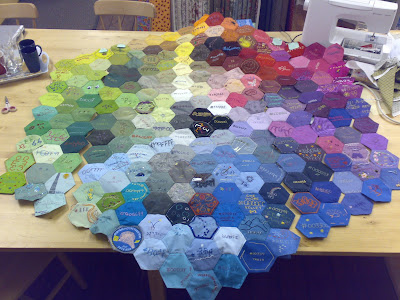
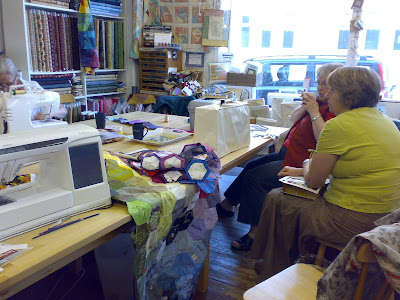
Kim and everyone at the Fat Quarters Shop in Blackhall Mill have done us proud! They have undertaken the fidddly finger numbing task of sewing the patches in rows, and then sewing the rows together. I finished the very last patch FF33FF on Tuesday afternoon and got the bus with Clare to Blackhall Mill. She took these great pics.
A special thanks to the Mini Stitchers group, and Shelia, Anne, Kathleen, Doreeen, Emma, Stella, pat, Mary, Sue and Di for all their beautiful patches and sewing prowess!
This weekend the patchwork will return to Sheffield to be completed and hemmed by Lisa, Tricia and Nicola ready for our exhibition at HTTP Gallery, which opens on Friday 16th May.
Friday, March 28, 2008
Jing's Patch
Her patch was then pinned in its place on the first column on the top half of the Patchwork at Isis Arts in Newcastle.
Thursday, March 27, 2008
The Last Patches
There are 40 patches left to make... And we now have a deadline! The completed Html Patchwork will be shown at HTTP Gallery at Furtherfield in London, opening on May 16th.
I am currently working at Isis Arts in Newcastle upon Tyne UK, and anyone in Newcastle who would like to take part can call Isis on 0191 - 2614407, or come along to the workshops or talk listed below. Isis Arts is on Charlotte Square in central Newcastle.
Several people have contacted me about how to make a patch. I now have a complete set of fabrics and can send you a patchwork kit with fabric, code, embroidery threads and a template. To see which fabric patches haven't been made - take a peek at the Patchwiki at www.open-source-embroidery.org.uk Scroll over the patches and double click to see if someone has added their details.
Good Luck!
I am currently working at Isis Arts in Newcastle upon Tyne UK, and anyone in Newcastle who would like to take part can call Isis on 0191 - 2614407, or come along to the workshops or talk listed below. Isis Arts is on Charlotte Square in central Newcastle.
Several people have contacted me about how to make a patch. I now have a complete set of fabrics and can send you a patchwork kit with fabric, code, embroidery threads and a template. To see which fabric patches haven't been made - take a peek at the Patchwiki at www.open-source-embroidery.org.uk Scroll over the patches and double click to see if someone has added their details.
Good Luck!
Monday, March 10, 2008
Ele at Isis Arts
So here I am installed in the Isis Arts Studio working on the Html Patchwork throughout March. I'm doing an audit of the patches, chasing up some that have been made and inviting people to fill the remaining gaps. If you'd like to pop in and see the patchwork, have a cuppa tea and maybe even make a patch feel free to come along between 12noon and 2pm on any of the following days. Or give Isis Arts a ring to make an appointment for another time.
Lunchtime Patchworkshops:
Wed 12th March
Thurs 13th March
Thurs 27th March
Fri 28th March
Wed 2nd April
Thurs 3rd April
Fri 4th April
Also - I'll be giving a talk about the Html Patchwork project at Isis Arts, along with Jake Harries, Arts programmer at Access Space. Jake will introduce the Access Space arts programme and its relationship to open source methodologies. The talk will be on Tuesday 1st April 5.30 - 8pm at Isis Arts, 5 Charlotte Square, Newcastle upon Tyne, UK.
Lunchtime Patchworkshops:
Wed 12th March
Thurs 13th March
Thurs 27th March
Fri 28th March
Wed 2nd April
Thurs 3rd April
Fri 4th April
Also - I'll be giving a talk about the Html Patchwork project at Isis Arts, along with Jake Harries, Arts programmer at Access Space. Jake will introduce the Access Space arts programme and its relationship to open source methodologies. The talk will be on Tuesday 1st April 5.30 - 8pm at Isis Arts, 5 Charlotte Square, Newcastle upon Tyne, UK.
Tuesday, February 05, 2008
Html Patchwork at Isis Arts
The Html Patchwork is now safely stored in my attic - but still only half complete. Thanks to everyone in Sheffield who has sent in their patches over christmas - especially everyone at the Totley Quilters and Nicola. The project has been on hold for a few months whilst I finished my PhD thesis - which I finally submitted last week. Phew! The good news is that during February and March I'll be concentrating on finishing the patchwork, organising the remaining patches on the wiki and the actual fabric. I'm looking forward to being artist-in-residence at Isis Arts in Newcastle from March 10th until early April, and will be hosting weekly drop-in patch workshops - watch this space for dates.
The range of patches is quite interesting, and everyone is coming up with their own theories about the different approaches to patch-working. Some people have created decorative designs to accompany their hexadecimal code, others have used a typographic approach to the lettering. Some use traditional stitches, others use free-form embroidery. Take a peek at the Patch wiki to see some of the completed patches www.open-source-embroidery.org.uk/wiki/
The range of patches is quite interesting, and everyone is coming up with their own theories about the different approaches to patch-working. Some people have created decorative designs to accompany their hexadecimal code, others have used a typographic approach to the lettering. Some use traditional stitches, others use free-form embroidery. Take a peek at the Patch wiki to see some of the completed patches www.open-source-embroidery.org.uk/wiki/
Subscribe to:
Posts (Atom)